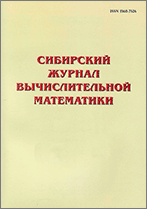|
|
Sibirskii Zhurnal Vychislitel'noi Matematiki, 2003, Volume 6, Number 4, Pages 347–379
(Mi sjvm199)
|
 |
|
 |
This article is cited in 6 scientific papers (total in 6 papers)
Climate and climate change: mathematical theory and numerical modeling
V. P. Dymnikov, E. M. Volodin, V. Ya. Galin, A. V. Glazunov, A. S. Gritsoun, N. A. Dianskii, V. N. Lykosov
Institute of Numerical Mathematics, Russian Academy of Sciences
Abstract:
In the paper, a climate system model constructed on the basis of coupling models of general circulation of the atmosphere and ocean is presented. This model does not use the correction of turbulent heat fluxes on the sea surface. The method to calculate the response operator of climatic models and real climatic system to small external perturbations of forcing is described. The method is based on the use of dissipation-fluctuation relations for systems with a large number of positive Lyapunov's exponents. To illustrate the effectiveness of the proposed method, some results of constructing an approximate response operator for the atmospheric general circulation model are discussed. Numerical experiments to reproduce the present-day climate have been carried out. Climatic characteristics simulated by the coupled model are compared to the characteristics obtained from the community of models participating in the project SMIP. The coupled atmosphere and ocean model response to an increase of the atmospheric CO2 concentration is analyzed. It is found that the maximal warming about 2–3.5 К takes place in the centre of Euroasia. During the cold season this warming is expressed stronger (3–5 K) than during the warm season (1–1.5 K). Approximately one third of the cold season warming in Euroasia (1–2 K)is explained by a change of the atmospheric dynamics, namely, by an increase of the arctic oscillation index.
Received: 28.04.2003
Citation:
V. P. Dymnikov, E. M. Volodin, V. Ya. Galin, A. V. Glazunov, A. S. Gritsoun, N. A. Dianskii, V. N. Lykosov, “Climate and climate change: mathematical theory and numerical modeling”, Sib. Zh. Vychisl. Mat., 6:4 (2003), 347–379
Linking options:
https://www.mathnet.ru/eng/sjvm199 https://www.mathnet.ru/eng/sjvm/v6/i4/p347
|

| Statistics & downloads: |
| Abstract page: | 887 | | Full-text PDF : | 841 | | References: | 76 |
|




 Contact us:
Contact us: Terms of Use
Terms of Use
 Registration to the website
Registration to the website Logotypes
Logotypes









 Citation in format
Citation in format 